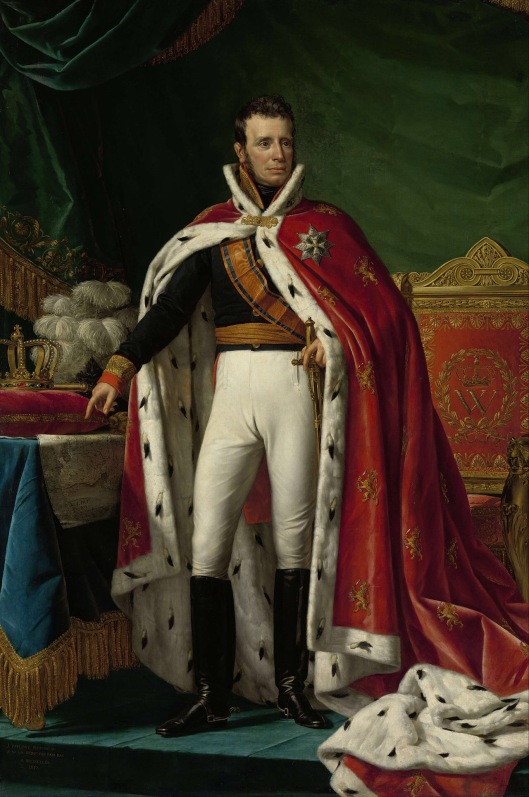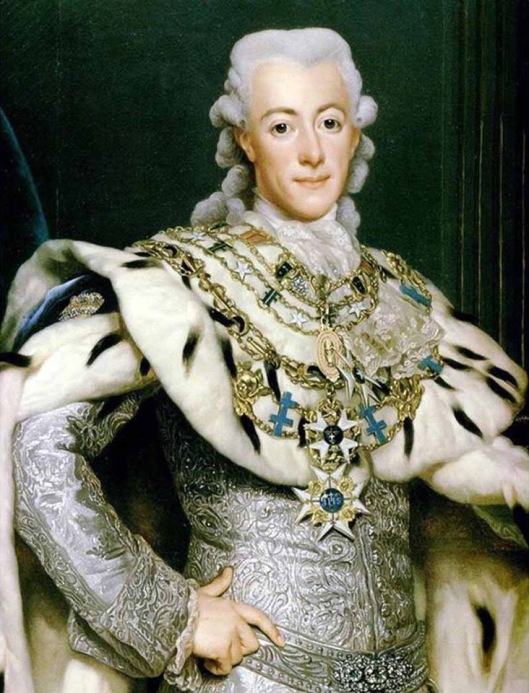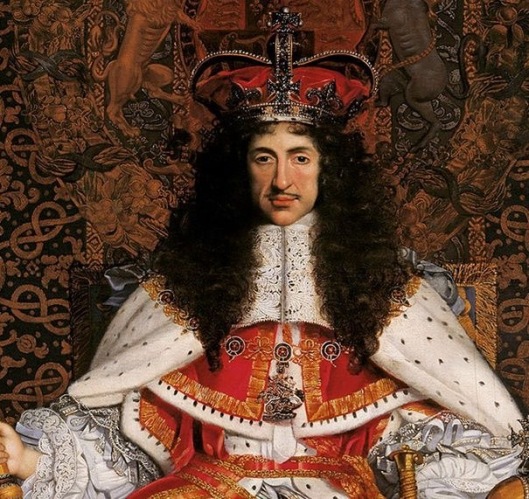Tags
Cathereine the Great, Denmark, Frederick the Great of Prussia, Frederik Adolf of Sweden, Gustav III of Sweden, Kingdom of Sweden, Parliament, Riksdag, Sophie Magdalena of Denmark, Sweden
The Revolution of 1772, also known as the Coup of Gustav III was a Swedish coup d’état performed by king Gustav III of Sweden on August 19, 1772 to introduce absolute monarchy against the Riksdag of the Estates, resulting in the end of the Age of libertyand the introduction of the Swedish Constitution of 1772.
First, a little personal information on the King of Sweden.

Gustav III (January 24, 1746 – March 29 1792) was King of Sweden from February 12, 1771 until his assassination in 1792. He was the eldest son of Adolf Frederik, King of Sweden and Queen Louise Ulrika (a sister of King Friedrich II the Great of Prussia), and a first cousin of Empress Catherine II the Great of Russia by reason of their common descent from Christian August of Holstein-Gottorp, Prince of Eutin, and his wife Albertina Frederica of Baden-Durlach.
Gustav married Princess Sophia Magdalena, by proxy in Christiansborg Palace, Copenhagen, on October 1, 1766 and in person in Stockholm on November 4, 1766. Princess Sophia Magdalena was the daughter of King Frederik V of Denmar-Norway and his first wife Princess Louise of Great Britain the youngest surviving daughter of King George II of Great Britain and Caroline of Ansbach.
Gustav was first impressed by Sophia Magdalena’s beauty, but her silent nature made her a disappointment in court life. The match was not a happy one, owing partly to an incompatibility of temperament, but still more to the interference of Gustav’s jealous mother, Queen Louisa Ulrika. The marriage produced two children: Crown Prince Gustav Adolf (1778–1837), (future King Gustav IV Adolf) and Prince Carl Gustav, Duke of Småland(1782–1783).
Gustav III was known in Sweden and abroad by his Royal Titles, or styles:
Gustav III, by the Grace of God, of the Swedes, the Goths and the Vends King, Grand Prince of Finland, Duke of Pomerania, Prince of Rügen and Lord of Wismar, Heir to Norway and Duke of Schleswig-Holstein, Stormarn and Dithmarschen, Count of Oldenburg and Delmenhors.

Revolution of 1772
Gustav III was a vocal opponent of what he saw as the abuse of political privileges seized by the nobility since the death of King Carl XII. At the time of his accession, the Swedish Riksdag held more power than the monarchy, but the Riksdag was bitterly divided between rival parties, the Hats and Caps. On his return to Sweden, Gustav III tried unsuccessfully to mediate between the bitterly divided parties. On June 21, 1771, he opened his first Riksdag with a speech that aroused powerful emotions. It was the first time in more than a century that a Swedish king had addressed a Swedish Riksdag in its native tongue. He stressed the need for all parties to sacrifice their animosities for the common good, and volunteered, as “the first citizen of a free people,” to be the mediator between the contending factions.
A composition committee was actually formed, but it proved illusory from the first: the patriotism of neither faction was sufficient for the smallest act of self-denial. The subsequent attempts of the dominant Caps to reduce him to being a powerless king encouraged him to consider a coup d’état. Under the sway of the Cap faction, Sweden seemed in danger of falling prey to the political ambitions of Russia. It appeared on the point of being absorbed into the Northern Accord sought by the Russian vice-chancellor, Count Nikita Panin. It seemed to many that only a swift and sudden coup d’état could preserve Sweden’s independence.

(King Gustav III of Sweden and his Brothers; Gustav III (left) and his two brothers, Prince Frederik Adolf and Prince Carl, later Carl XIII of Sweden. Painting by Alexander Roslin.)
Gustav III was approached by Jacob Magnus Sprengtporten, a Finnish nobleman, who had incurred the enmity of the Caps, with the prospect of a revolution. He undertook to seize the fortress of Sveaborg in Finland by a coup de main. Once Finlandwas secured, he intended to embark for Sweden, join up with the king and his friends near Stockholm, and force the estatesto accept a new constitution dictated by the king.
At this juncture, the plotters were reinforced by Johan Christopher Toll another victim of Cap oppression.
Toll proposed to raise a second revolt in the province of Scania, and to secure the southern fortress of Kristianstad. After some debate, it was agreed that Kristianstad should openly declare against the government a few days after the Finnish revolt had begun. Duke Carl, the eldest of the king’s brothers, would thereupon be forced to mobilize the garrisons of all the southern fortresses hastily, ostensibly to crush the revolt at Kristianstad, but on arriving in front of the fortress, he was to make common cause with the rebels and march upon the capital from the south while Sprengtporten attacked it simultaneously from the east.
On August 6, 1772, Toll succeeded in winning the fortress of Kristianstad by sheer bluff, and on August 16, Sprengtporten succeeded in surprising Sveaborg, but contrary winds prevented him from crossing to Stockholm. Events soon occurred there that made his presence unnecessary in any case.
On August 16, the Cap leader, Ture Rudbeck, arrived at Stockholm with news of the insurrection in the south, and Gustav found himself isolated in the midst of enemies. Sprengtporten lay weather-bound in Finland, Toll was 500 miles away, the Hat leaders were in hiding. Gustav thereupon resolved to strike the decisive blow without waiting for Sprengtporten’s arrival.

He acted promptly. On the evening of August 18, all the officers whom he thought he could trust received secret instructions to assemble in the great square facing the arsenal on the following morning. At ten o’clock on August 19, Gustav III mounted his horse and rode to the arsenal. On the way, his adherents joined him in little groups, as if by accident, so that by the time he reached his destination he had about 200 officers in his suite.
After parade he reconducted them to the guard-room in the north western wing of the palace where the Guard of Honour had its headquarters and unfolded his plans to them. He told the assembled officers,
“If you follow me, just like your ancestors followed Gustav Vasa and Gustavus Adolphus, then I will risk my life and blood for you and the salvation of the fatherland!”
A young ensign then spoke up:
“We are willing to sacrifice both blood and life in Your Majesty’s service!”
Gustav then dictated a new oath of allegiance, and everyone signed it without hesitation. It absolved them from their allegiance to the estates, and bound them solely to obey “their lawful king, Gustav III”.
Meanwhile, the Privy Council and its president, Rudbeck, had been arrested and the fleet secured. Then Gustav made a tour of the city and was everywhere received by enthusiastic crowds, who hailed him as a deliverer. A song was composed by Carl Michael Bellman called the “Toast to King Gustav!”
Now in full control of the government the king initiated a campaign to restore a measure of Royal autocracy, which was completed by the Union and Security Act of 1789, which swept away most of the powers exercised by the Swedish Riksdag (parliament) but at the same time it opened up the government for all citizens. This reinforced monarchical authority significantly, although the estates retained the power of the purse, it did hereby broke the privileges of the nobility.
The next day, August 20, 1772 a new constitution was imposed upon the Riksdag of the Estates by Gustav III which converted a weak and disunited republic into a strong but limited monarchy. The estates could assemble only when summoned by him; he could dismiss them whenever he thought fit; and their deliberations were to be confined exclusively to the propositions which he laid before them. But these extensive powers were subjected to important checks. Thus, without the previous consent of the estates, no new law could be imposed, no old law abolished, no offensive war undertaken, no extraordinary war subsidy levied. The estates alone could tax themselves; they had the absolute control of the Riksbank – the Bank of Sweden, and the right of controlling the national expenditure.
In 1789 the king further strengthened his power. The Union and Security Act, alternatively Act of Union and Security, was proposed by king Gustav III of Sweden to the assembled Estates of the Realm during the Riksdag of 1789. It was a document, adding to the Swedish Constitution of 1772 new provisions. The King strengthened his grip on power while at the same time riding on a popular wave that also meant a decrease in aristocratic power. It has been described as “fundamentally conservative”.
The Act of Union and Security gave the king the sole power to declare war and make peace instead of sharing the power with the estates and the Privy Council. The estates would lose the ability to initiate legislation, but they would keep the ability to vote on new taxes.
Another provision was that the King was enabled to determine the number of Privy Councillors and so he could abolish the Council altogether by determining their number to be zero. The judicial branch of the Privy Council (in Swedish: Justitierevisionen) was then transferred to a new Supreme Court.
Most noble privileges were abolished with the Act, with most offices now available to all regardless of rank. Noble lands could now be bought by anyone instead of only by nobles.





